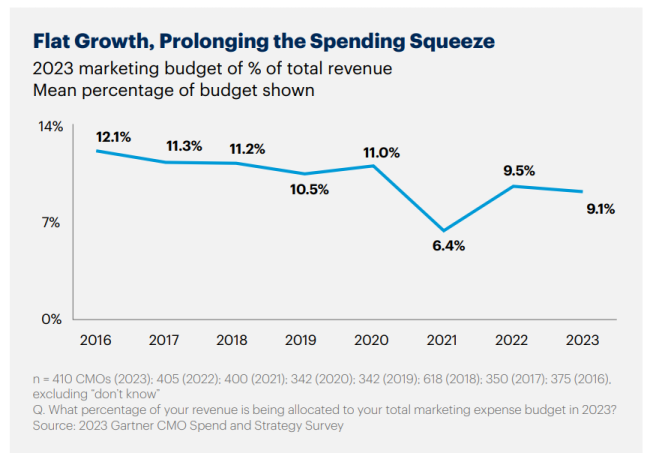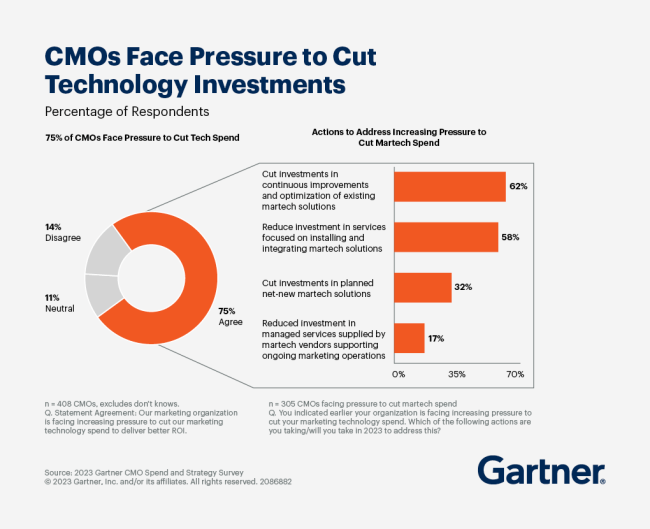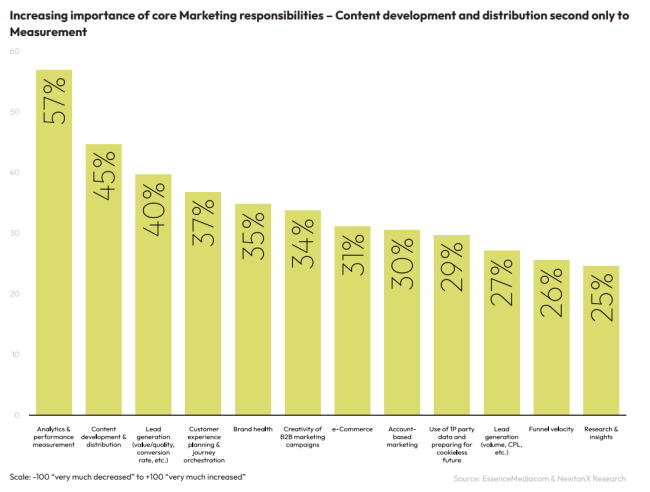The digital revolution in marketing brought about unparalleled growth in both its reach and financial power. With the introduction of new channels and technologies, investments surged. However, the pandemic introduced a phase of budgetary stagnation, compelling CMOs to reconsider spending on once-indispensable areas like marketing technology.
Gartner’s annual CMO Spend and Strategy Survey, which encompasses hundreds of CMOs, traces the trajectory of marketing expenditures over time. It provides insights for enterprise leaders on driving results and fostering growth in tighter financial times.
The Digital Evolution in Marketing
Around two decades ago, the digital marketing era began, symbolised by the inclusion of ‘digital’ in job titles. This initiated the ‘era of more’ offering marketers expansive opportunities to connect with consumers, yet challenging CMOs to balance budgets between digital and traditional avenues. By 2016, digital channels and martech dominated marketing budgets, with Gartner’s survey indicating they constituted 12.1% of company revenue, and by 2018, a significant 29.2% of these funds were directed towards technology.
The Pandemic’s Dual Impact

Unsplash
The unforeseen advent of the pandemic in 2020 wreaked havoc on marketing budgets and altered customer interactions. Yet, it also accelerated the shift towards digital and technology. Brands, irrespective of their prior digital investments, had to pivot to digital channels to engage with their confined audiences. Consequently, even in times of reduced budgets, there was a surge in e-commerce, digital channels, and tech utilisation.
The Uphill Recovery Post-Covid
Despite the World Health Organization declaring the end of the Covid-19 global health emergency, the aftermath lingers. Challenges like higher interest rates affecting ROI potential, a challenging talent market, and lagging digital transformation persist. For instance, the 2023 Gartner Board of Directors Survey revealed that 81% of boards hadn’t progressed towards or achieved their digital transformation goals. Additionally, a 2022 Gartner survey found that 67% of CFOs felt that digital spending over the past three years hadn’t met enterprise expectations.
 The 2023 Landscape
The 2023 Landscape
Gartner’s 2023 survey indicates a shift from the era of abundance to one of constraint. The survey of over 400 CMOs from North America and Europe revealed that marketing budgets haven’t rebounded to pre-Covid levels. Average budgets decreased from 9.5% of company revenue in 2022 to 9.1% in 2023. Furthermore, 70% of respondents felt their enterprises lacked the budget to execute their 2023 marketing strategies effectively.
 Martech Utilisation: Maximising ROI
Martech Utilisation: Maximising ROI
Assessing the right funding for marketing technology investments is challenging, especially when ensuring full utilisation. Despite martech being a significant portion of modern marketing budgets, CMOs often find it hard to showcase its ROI. Gartner’s research indicates a decline in martech utilisation rates, dropping from 58% in 2020 to a mere 42% in 2022. Instead of addressing operational issues or flaws in their current systems, many CMOs are inclined to seek new solutions, banking on martech’s proven potential to enhance marketing efficiency. To maximise budget efficiency, CMOs should prioritise tech stack components that tangibly enhance marketing results and align with their marketing strategy. A holistic martech strategy should aim to optimise both current and new technologies, evaluating whether to invest in new tools or leverage existing ones based on their alignment with business outcomes.
 Rising Emphasis on Analytics and ROI
Rising Emphasis on Analytics and ROI
B2B senior marketing leaders identify analytics and performance measurement as their most heightened responsibility. EssenceMediacom’s Global B2B Marketing Report 2023 presents the results of a study of Fortune 500 marketing leaders. 57% of respondents emphasised the growing importance of business results like sales and ROI, while 43% highlighted the need to demonstrate the effectiveness of marketing investments through metrics like ROMI. Furthermore, 57% ranked ‘proving ROI’ among their top three challenges. This pressure is intensified by the growth in B2B marketing budgets, with 70% reporting an increase over the past three years and 42% seeing a rise of over 10%. Of those with growing budgets, 75% have channelled additional funds into data and technology, adding both opportunities and complexities to CMO roles.
Growing Pressure from CFOs
This emphasis aligns with the fact that pressure on CMOs from CFOs to demonstrate the value of marketing has intensified, as per The CMO Survey. While 52% of CMOs feel increased pressure from CFOs, up from 45% two years ago, the pressure from CEOs has decreased to 51% from 58%, and from Boards to 33% from 39%. A significant challenge for these senior marketers is showcasing the financial impact of marketing, with 61.2% finding it tough. This surpasses other challenges like emphasising the role of brand in business decisions (45.3%) or securing support for new marketing investments (40.7%).
The Road Ahead

As for 2024, the future remains unpredictable. New technologies and channels might usher in another era of growth for marketing. However, the lessons from the current constrained phase could lead to more streamlined and efficient marketing strategies in the future.
Sources
Gartner’s 2023 CMO Spend and Strategy Survey
Gartner’s survey—download page
EssenceMediacom’s Global B2B Marketing Report 2023










